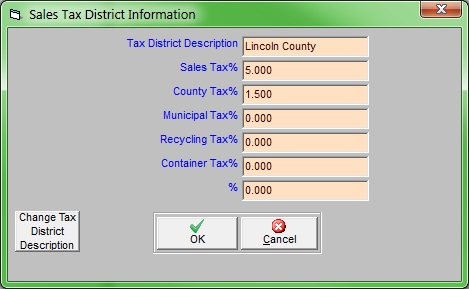Description
Sales tax districts are a way to organize customers based on whether they pay taxes, what rates they are taxed at, and which entities (state, city, etc.) receive the money.
Before You Begin
You should enter your fee descriptions before entering your sales tax districts (and finish both before you begin to assign districts to customers).

Context
Trash Flow lets you create sales tax districts that accurately charge the different taxes that your customers pay. Many of Trash Flow’s reports can be run by Sales Tax District, and an option on the Posting Report includes the information you need to file your taxes.
When a customer is assigned a sales tax district, any taxable charges made to them will automatically have the sales tax rate(s) added on. Likewise, in the case of payments received, the appropriate amount of sales tax will be deducted from the total payment amount and attributed to the appropriate tax category. The calculation used to determine the amount of sales tax taken out of a payment, credit, or write-off is based on the amount of tax that has been charged to that account. (If a payment is made before the charges then Trash Flow simply takes its best guess and withholds the exact percentage of tax for the district.) If there is a mixture of taxable and nontaxable charges, then the percentage of a payment that is taken for tax will be different than the percentage set for this district.
If a customer pays different tax rates(such as having containers in different towns) then the correct way to handle things is to set up each locality where they might be taxed as a new customer account, then use the Bill-to function to make it a sub-account of the main customer. You can set up as many container placements as necessary on those sub-accounts as long as all those placements are paying the same tax rate.
- Container Example: Let's say that BURNS CONSTRUCTION does some of their building in rural locations, some in Springfield, and some in Shelbyville. You'd end up with three customer accounts: BURNS CONSTRUCTION as the main one and something like BURNS CONSTR. - SPRINGFIELD and BURNS CONSTR. - SHELBYVILLE. On the latter two you'd go to the Bill to field on the Rates tab and enter BURNS CONSTRUCTION. All the construction projects in Springfield and in Shelbyville could then be set up as container placements on their respective accounts.
Steps to follow
- Click .
- Type the name of the region you’re defining (for example, Lincoln County or Springfield) and press Enter.
- A window will inform you that you’ve entered a new Tax District and ask you to confirm if you want to Add This Name; click .
- A window will appear with the fee descriptions you set up earlier. The first percentage line in Sales Tax District Information will be matched up with Description 0 from the Fee Descriptions screen, the second line with Description 1, etc. For each description, enter the sales tax percentages that customers in this region have to pay. (If you’re only using the district for tracking purposes, leave all the rates set to 0.000.)
- Click to save your changes.
When you're done
Once the districts have been created you can assign sales tax districts to customer accounts.
